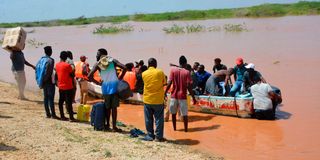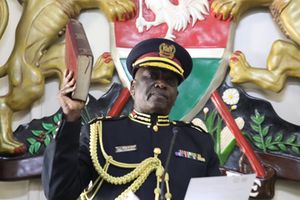Tana River leaders seeking lasting solutions to effects of perennial floods

Residents of Gamba area in Tana River County using a canoe to transport food and other supplies following heavy floods in this picture taken on December 3, 2023.
What you need to know:
- Galole MP Said Buya Hiribae challenged the national government to respond to floods and offer a permanent solution.
- His sentiments were echoed by Garsen MP Ali Guyo Wario who urged the national government to support the housing program in the area.
Tana River County leaders, led by Governor Dhadho Godhana, have asked the national government to support long-term plans by the county government to end the perennial effects of floods and drought in the area.
Tana River County is among the counties that are usually worst hit by floods and drought every year.
Several plans initiated in the past have failed, the latest being the stalled construction of eco-villages on higher grounds for residents who are often affected by floods in the lowlands.
During the 2018 floods that displaced thousands of residents, the national government, through the Kenya Red Cross Society, constructed houses worth Sh1 billion in villages that had experienced the floods, only for them to be swept away by floods in 2020.
Before the dust settled, the current floods have yet again destroyed homes and several government installations.
When he was first elected as County boss in 2017, Mr Godhana had come up with a village cluster program that would make residents residing along the River Tana move permanently to higher grounds.
However, the governor is serving his second term with that flagship program still stagnated due to lack of funds, lack of political goodwill and lack of interest from the national government.
Work in six villages had started with the construction of cabro roads, connection to water supply and water pans and medium-sized dams constructed.
In the program, pieces of land for 19 villages along Kenya’s longest river stretching from Madogo near Garissa to Garsen had been identified several kilometers from the river and residents were ready to move in the new clusters villages and reserve their current villages for agriculture and other uses.
The goal was to relocate 48 villages comprising at least 200,000 residents residing in flood-prone areas.
Social amenities, infrastructure such as roads and government installations, dams, long-distance water canals, water pans and boreholes were part of the ingredients of the cluster program.
Speaking at his official residence, Mr Godhana said the Sh3.5 billion program would have been a game-changer and that the current flood emergencies could not have arisen.
“The village cluster program failed to get attention from the national government hence there has been slow progress and the aim of the program was to settle people in villages and towns on higher grounds and reserve the flood-prone areas for agricultural and other activities,” he said.
He maintained that the flooding of River Tana was a natural phenomenon.
“The problem of Tana River is not the river itself, but because Tana River is a low land county, so floods come from all directions. People should not demonise the flooding because those floods are the only way restoration of the ecosystem of Tana areas, especially Tana Delta will be done and without that then many livelihoods will be affected,” he said.
“We have the main river there and we have the seasonal rivers that run three months every year but because of the El Nino, they are going to run for seven months and that is a very long period for those kinds of rivers,” he added.
A visit to the Handampya cluster whose construction stopped, shows the area has not been affected by flooding as is the case with several places including Hola town, the County headquarters.
“We are constructing in phases and all departments have budgets aligned to the cluster programs. The private sector is also welcome to make the program a success,” said Governor Godhana.
According to the governor, there are plans to construct dams to harvest surface water for irrigation purposes, especially in the hinterlands.
“Harvesting of the surface water will also help us in curbing drought since that water will be used during the dry seasons,” he said.
He called for partnership with relevant authorities to ensure the cluster program becomes a success.
Galole MP Said Buya Hiribae challenged the national government to respond to floods and offer a permanent solution.
His sentiments were echoed by Garsen MP Ali Guyo Wario who urged the national government to support the housing program in the area.




